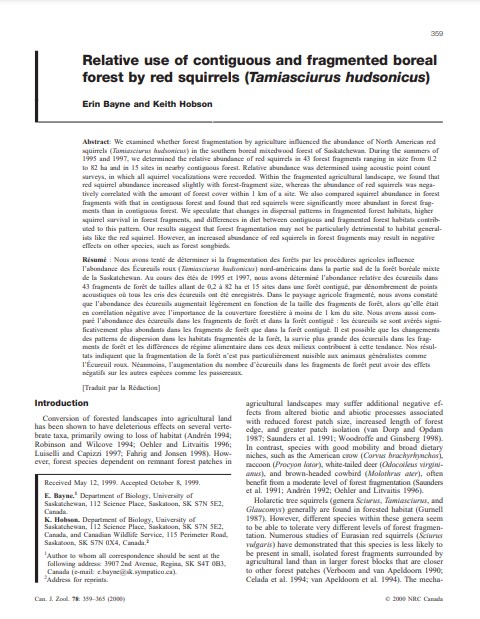Relative use of contiguous and fragmented boreal forest by red squirrels (Tamiasciurus hudsonicus)
Bosque Modelo:
Prince Albert
Temática:
Desarrollo humano
Tipo de documento:
Artículo científico
Resumen
We examined whether forest fragmentation by agriculture influenced the abundance of North American red squirrels (Tamiasciurus hudsonicus) in the southern boreal mixedwood forest of Saskatchewan. During the summers of 1995 and 1997, we determined the relative abundance of red squirrels in 43 forest fragments ranging in size from 0.2 to 82 ha and in 15 sites in nearby contiguous forest. Relative abundance was determined using acoustic point count surveys, in which all squirrel vocalizations were recorded. Within the fragmented agricultural landscape, we found that red squirrel abundance increased slightly with forest-fragment size, whereas the abundance of red squirrels was negatively correlated with the amount of forest cover within 1 km of a site. We also compared squirrel abundance in forest fragments with that in contiguous forest and found that red squirrels were significantly more abundant in forest fragments than in contiguous forest. We speculate that changes in dispersal patterns in fragmented forest habitats, higher squirrel survival in forest fragments, and differences in diet between contiguous and fragmented forest habitats contributed to this pattern. Our results suggest that forest fragmentation may not be particularly detrimental to habitat generalists like the red squirrel. However, an increased abundance of red squirrels in forest fragments may result in negative effects on other species, such as forest songbirds.
Información Bibliográfica
Autor:
Bayne E and K Hobson.
Revista:
Canadian Journal of Zoology
Año:
2000
N°:
3
País :
Canadá
Páginas:
359 - 365
Volumen:
78
Idioma:
Ingles
Palabras claves
Boreal forest, red squirrel,Tamiasciurus hudsonicus





